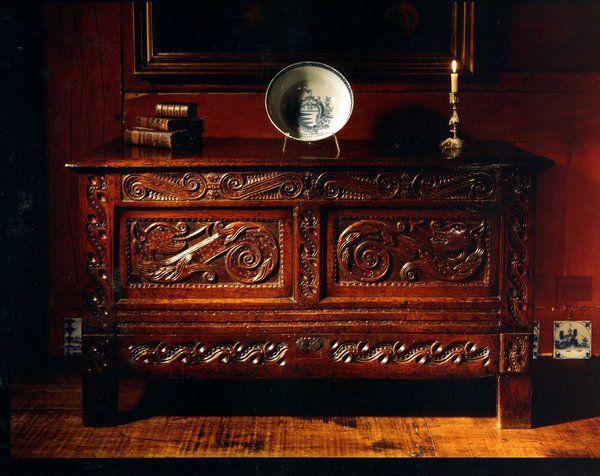A fine, mid-17th century, oak chest with exceptional and rare carving
10631
The plank top with moulded edge opening to reveal an interior with a fitted candle- box, replaced hinges and lock. The frieze, stiles and bottom rail finely carved with stylised "S" scoll decoration. The front with two inset panels each containing a finely carved wivern (a two-legged, winged monster). Excellent original colour and patination. English, probably South Lancashire and perhaps Manchester, circa 1630. 3036725.
Reference: Oak Furniture (Chinnery) fig 4:151, 4:158 and 4:163. "Another exciting subject is the stylised dragon which sometimes appears on chairs or chests. These may take the form of a fully integrated panel (figure 4:163), or simply dragon-head finials incorporated intoa larger design as in the crests of figures 4:113 and 4:151. A pair of backstools very simiar to figure 4:158 have been at Chetham's Hospital since the 17th century, in the old market town of Manchester."
Width: 128.00 cm./50.25 in.
Height: 74.00 cm./29.00 in.
Depth:
56.00 cm./22.00 in.
The carving on this Carolean chest is exceptional and both the condition and colour excellent.
The chest was the principal piece of medieval domestic furniture and served as a table, seat and travelling trunk as well as for the safe keeping of documents, clothing and household items.
The typical English chest of the late 16th and early 17th century is simple in design. The framework is grooved and moulded or carved, while the richest carving is reserved for the panels. The end-panels are usually plain, the top rails however are sometimes carved to correspond to the front. In chests of Charles I reign a drawer first appears, and the horizontal division of the piece is emphasised by a projecting moulding. This introduction of a drawer in the lower part of chests was a significant because it was the first stage in the evolution of the chest of drawers.
17th Century
1650
England










